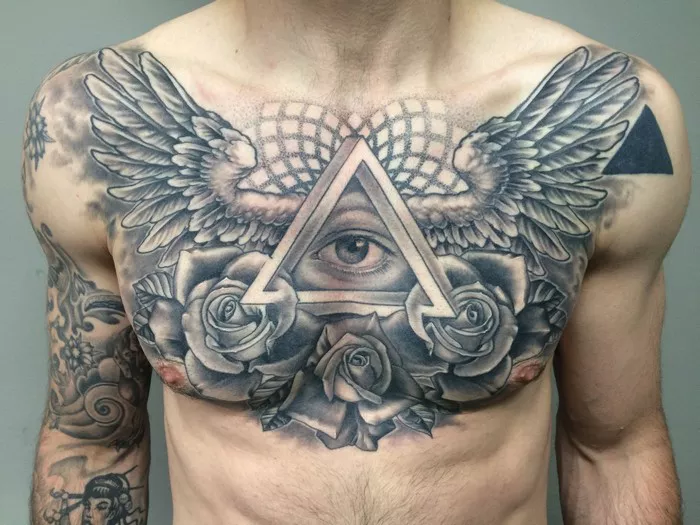Tattoos have long been recognized as a form of self-expression, with enthusiasts seeking to adorn their bodies with meaningful symbols, intricate designs, or vibrant imagery. Among the popular areas for tattoo placement, the chest stands out as both a canvas for creativity and a zone known for its significant discomfort during the tattooing process. In this article, we delve into the intricate dynamics of chest tattoo pain, exploring its intensity, influencing factors, pain management techniques, healing process, and professional insights from experienced tattoo artists.
Pain Level Description
Embarking on a chest tattoo journey necessitates an understanding of the pain involved. Pain perception is subjective and varies widely among individuals. However, chest tattoos are generally regarded as high on the pain scale due to their proximity to sensitive areas like the ribs and sternum bone. The skin over the chest tends to be thinner compared to other body parts, amplifying the sensation of pain during the tattooing process. Furthermore, the presence of nerve endings and blood vessels in this region contributes to heightened sensitivity, making the experience more intense for many individuals.
Factors Influencing Pain
Several factors influence the level of pain experienced during a chest tattoo session.
1. Individual Pain Tolerance: One of the primary determinants of pain perception is an individual’s pain tolerance level. While some may find chest tattooing bearable, others may struggle with the discomfort. Factors such as past experiences with pain, psychological factors, and overall health can all impact an individual’s ability to endure the sensation.
2. Muscle and Fat Distribution: The distribution of muscle and fat in the chest area can affect pain perception during tattooing. Thicker layers of muscle and fat may provide some cushioning and reduce the intensity of the sensation, whereas individuals with leaner builds may experience more pronounced discomfort as the needle comes into closer contact with bone and nerve endings.
3. Specific Location on the Chest: Different areas of the chest may elicit varying levels of pain. Tattoos closer to the sternum or over the ribs tend to be more painful due to the proximity to bone and the presence of less flesh between the skin and underlying structures. Conversely, areas with more flesh, such as the pectoral muscles, may be comparatively less painful to tattoo.
Comparison with Other Areas
To provide context for the pain associated with chest tattoos, it’s helpful to compare it with other commonly tattooed body parts. While pain perception is subjective, many tattoo enthusiasts report chest tattoos as being among the more painful areas to ink.
For instance, tattoos on the outer arm or calf muscle are often considered less painful due to the abundance of flesh and muscle in these areas, providing a buffer between the skin and underlying bone. In contrast, areas with less flesh, such as the ribcage, spine, or collarbone, tend to be more sensitive and painful to tattoo.
Pain Management Tips
Despite the anticipated discomfort, there are various strategies to help manage and alleviate pain during a chest tattoo session.
1. Breathing Techniques: Deep breathing exercises can help promote relaxation and distract from the sensation of pain. Instructing clients to focus on slow, rhythmic breathing can reduce anxiety and discomfort during the tattooing process.
2. Scheduled Breaks: Taking regular breaks during the tattoo session allows clients to rest and recalibrate their pain threshold. Short intervals provide an opportunity to hydrate, stretch, and mentally prepare for the next phase of the tattooing process.
3. Numbing Creams: Some tattoo artists may recommend the use of topical numbing creams to minimize discomfort. These creams are applied to the skin before the tattooing process begins and work by dulling the sensation of pain. However, it’s essential to follow the artist’s instructions regarding the application and timing of numbing creams to ensure optimal effectiveness.
Healing Process
Once the tattooing process is complete, proper aftercare is crucial to promote healing and minimize discomfort.
1. Keep the Area Clean: Following the tattoo session, it’s essential to keep the tattooed area clean to prevent infection. Gently wash the tattoo with mild soap and water, patting it dry with a clean towel.
2. Moisturize Regularly: Applying a thin layer of fragrance-free moisturizer to the tattooed area helps keep the skin hydrated and promotes healing. Avoid products containing alcohol or fragrances, as these can irritate the skin.
3. Avoid Irritants: During the healing process, avoid activities that may irritate the tattooed skin, such as swimming, excessive sweating, or wearing tight clothing. Protect the tattoo from direct sunlight to prevent fading and irritation.
Professional Advice
Experienced tattoo artists offer valuable insights into managing pain and discomfort during chest tattoo sessions.
According to renowned tattoo artist, Sarah Thompson, “Communication is key when it comes to managing pain during a chest tattoo. I encourage my clients to voice their discomfort levels so we can adjust the pace and intensity of the session accordingly. Additionally, employing distraction techniques like engaging conversation or playing music can help divert attention from the sensation of pain.”
Similarly, David Rodriguez, a seasoned tattooist, emphasizes the importance of mental preparedness. “Preparing mentally for a chest tattoo is just as crucial as physical preparation. I advise my clients to visualize the end result and focus on the meaning behind their tattoo, which can serve as a powerful distraction from the discomfort.”
In conclusion, chest tattoos are revered for their aesthetic appeal and symbolic significance, but they come with a level of pain that varies among individuals. By understanding the factors influencing pain perception, employing effective pain management techniques, and following proper aftercare protocols, individuals can navigate the chest tattooing process with greater ease and comfort. Consulting with experienced tattoo artists and heeding their professional advice can further enhance the overall tattooing experience, ensuring a successful outcome that is both visually striking and minimally discomforting.

